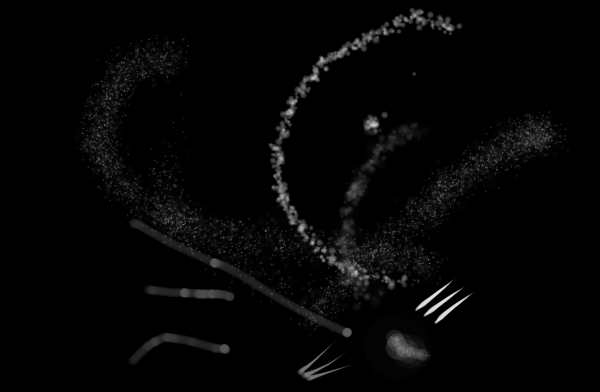This sounds like ARSE
This entry has been recreated from an old blog. Original title, not possible due to technical limitations: This sounds like ARSE! How did you do that?
Well, it's not ARSE anymore, but ARSS, but I prefer the maiden name. This post is about a little workflow to create music or noise in an uncommon way, by painting it.
The Tools
- mypaint
- convert
- arss
First you need a paint tool of sorts. I like mypaint for its many different fancy brushes, but you can use whatever you want. In order to process our painting further we need it as a bitmap (.bmp). Mypaint can't save in this format, so you can use something like the 'convert' program from the imagemagick package, but you could also use gimp or something, but I consider this overkill for such a simple task.
The centerpiece of this setup is ARSS, The Analysis & Resynthesis Sound Spectrograph. It was formerly abbreviated ARSE (Analysis & Reconstruction Sound Engine), which, as mentioned before, I like way more. Anyway, this little piece of software can convert between images and sounds, and we'll use it for just that. Let's Paint!
Well, there's not much to say here, I certainly can't tell you how or what to paint. I know nothing about painting, but I have a few hints that might help you:
- As far as I can tell, colour doesn't matter, so you don't need to bother with it. But brightness (or value, I don't know, I'm no graphics guy) does matter, so a greyscale picture makes perfect sense.
- Paint white on a black background. White makes sound, so black on white will be very noisy, you'd be painting a 'negative' so to speak.
- It analyses the picture from left to right (time) and from bottom to top (pitch)
- When saving in mypaint, use the 'PNG solid with background (*.png)' option, it's the only one convert can be converted to the correct bitmap format.
You don't necessarily need to paint youself, you could also use your holiday pictures or .. well, anything really. The ARSS homepage has a couple of good examples.
Hardly anything comes as a bitmap, so you'll need to convert it to a 24-bit .bmp. This line oughta do it:
convert -depth 24 source_image.png useable_by_arss_image.bmp
Here's my great painting (scaled down), can you see how much love went into it?

Let the ARSE do its Magick!
Now cast the following spell:
arss useable_by_arss_image.bmp amazing_sounds.wav -s --min-freq 55 -max 16000 --pps 100 -r 44100 -f 32
Don't be scared, you could just call arss without anything and it will prompt you for those parameters one by one. I prefer the commandline because of handy shell features such as history and tab completion. ARSS is reasonably well documented, arss --help, the documentation as well as the aforementioned examples should help you with the parameters. I was lazy here and just used pretty much the example line found in arss --help, but feel free to experiment. In my experience the -s (sine) option is a lot faster than -n (noise) and sounds similar most of the time.
Here's what my great painting from above sounds like, first using -s, then -n (concatenated and converted to vorbis).
ARSS has lots of options and they all can make the same picture sound quite different, so experiment, and have fun painting your sounds :)
Thanks go to gordonjcp this time who introduced me to ARSS several months ago using a painted amen-break.